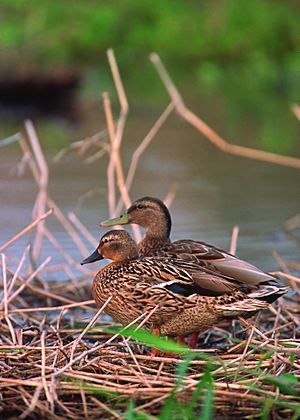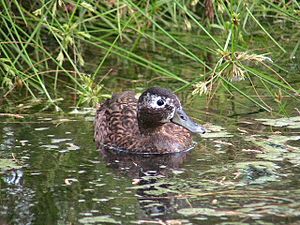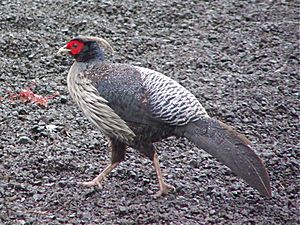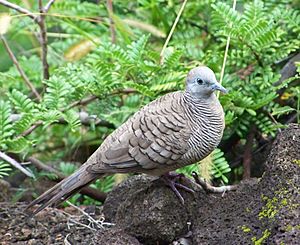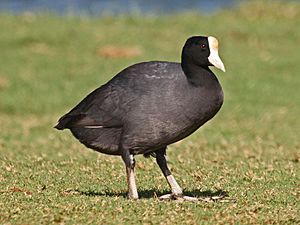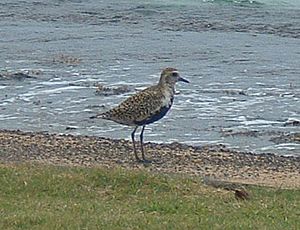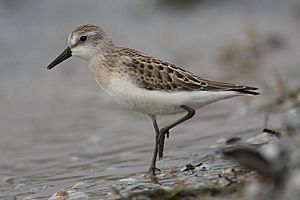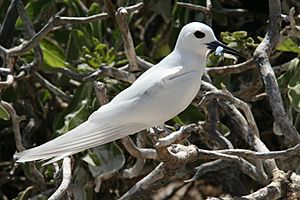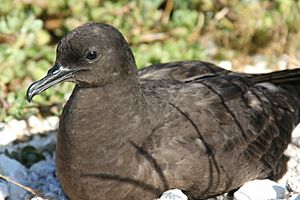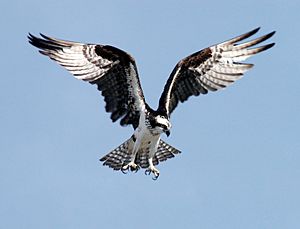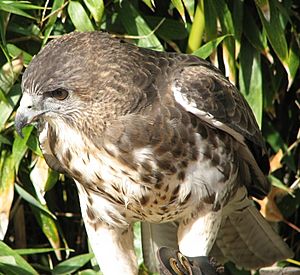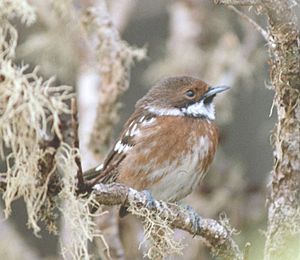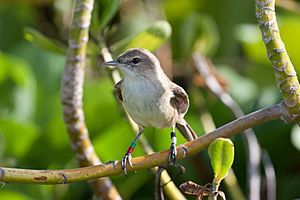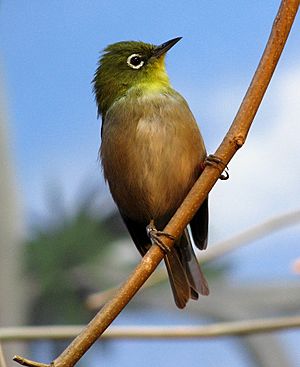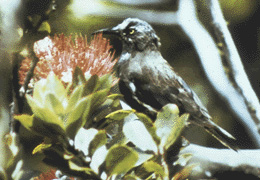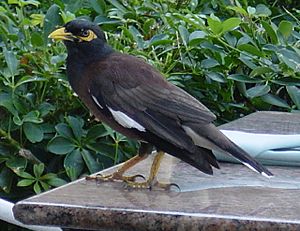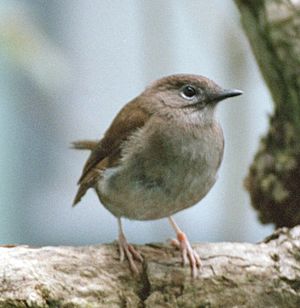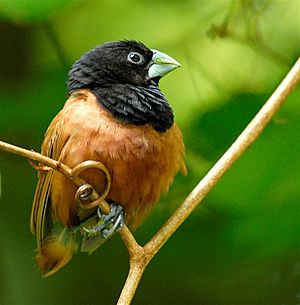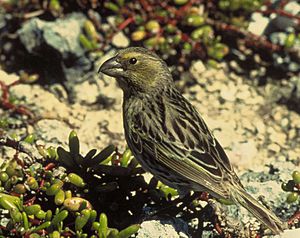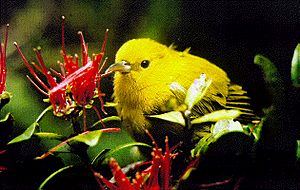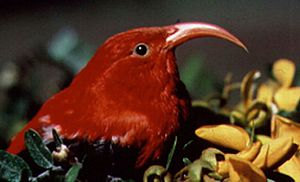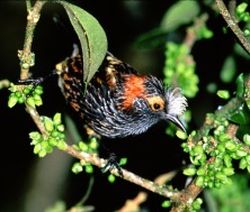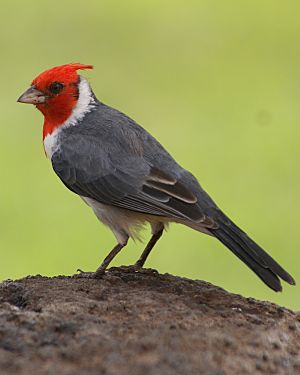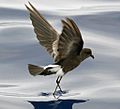List of birds of Hawaii facts for kids
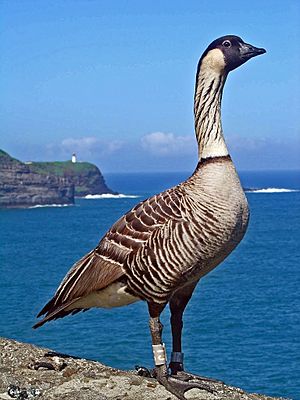
This guide lists all the amazing bird species that naturally live or visit the U.S. state of Hawaii. It covers the entire chain of Hawaiian Islands, from Kure Atoll in the north to the "Big Island" of Hawaii in the south. There are 337 different bird species on this list!
Many of these birds are special:
- 64 species are endemic, meaning they are found only in Hawaii.
- 130 species are vagrants, which are visitors that don't usually live here.
- 52 species were introduced by humans.
Sadly, 33 of the 64 endemic species are now extinct, meaning they no longer exist anywhere. Also, two introduced species that used to live here are now extirpated, meaning they no longer live in Hawaii but can still be found elsewhere in the world. This list doesn't include introduced species that haven't made Hawaii their permanent home yet.
The birds are listed in a scientific order, similar to how they are organized by the American Ornithological Society (AOS). This helps scientists keep track of all the different bird families.
Understanding Bird Status in Hawaii
To help you understand where each bird comes from or its situation, we use these special codes:
- (En) Endemic: This bird lives only in the Hawaiian Islands.
- (V) Vagrant: This bird is a rare visitor and doesn't live in Hawaii regularly.
- (Xt) Extinct: This bird no longer exists anywhere in the world.
- (xd) Extirpated: This bird no longer lives in Hawaii, but you can find it in other places.
- (I) Introduced: Humans brought this bird to Hawaii, and it now has a healthy breeding population here for at least 15 years.
We also use symbols from the IUCN Red List (International Union for Conservation of Nature) to show how safe or endangered a species is around the world. These symbols tell us if a bird is doing well or if it needs help.
| = least concern | = near threatened | = vulnerable |
| = endangered | = critically endangered | = extinct in the wild |
| = extinct |
Contents
- Understanding Bird Status in Hawaii
- Ducks, Geese, and Waterfowl: Pond & Lake Birds
- Pheasants, Grouse, and Allies: Game Birds
- Pigeons and Doves: Common City Birds
- Rails, Gallinules, and Coots: Shy Water Birds
- Stilts and Avocets: Long-Legged Waders
- Lapwings and Plovers: Shoreline Explorers
- Sandpipers and Allies: Diverse Shorebirds
- Gulls, Terns, and Skimmers: Ocean Flyers
- Albatrosses: Giants of the Sky
- Shearwaters and Petrels: Ocean Wanderers
- Boobies and Gannets: Diving for Fish
- Herons, Egrets, and Bitterns: Wading Birds
- Osprey: The Fish Hunter
- Hawks, Eagles, and Kites: Powerful Hunters
- Owls: Nighttime Hunters
- Falcons and Caracaras: Fast Predators
- New World and African Parrots: Colorful Talkers
- Old World Parrots: More Colorful Friends
- Monarch Flycatchers: Insect Eaters
- Crows, Jays, and Magpies: Smart Birds
- Reed Warblers and Allies: Plain but Unique
- Bulbuls: Fruit Lovers
- White-eyes, Yuhinas, and Allies: Ring Around the Eye
- Hawaiian Honeyeaters: Extinct Nectar Feeders
- Mockingbirds and Thrashers: Amazing Mimics
- Starlings: Social Birds
- Thrushes and Allies: Ground Feeders
- Waxbills and Allies: Seed Eaters
- Old World Sparrows: Common Backyard Birds
- Finches, Euphonias, and Allies: Hawaiian Honeycreepers
- Cardinals and Allies: Strong-Billed Birds
- Tanagers and Allies: Brightly Colored Birds
- Images for kids
- See also
Ducks, Geese, and Waterfowl: Pond & Lake Birds
Order: Anseriformes Family: Anatidae
This family includes ducks, geese, and swans. These birds are perfectly built for life in the water. They have webbed feet for swimming, flat bills for finding food, and special feathers that shed water easily.
- Nene, Branta sandvicensis (En)
- Laysan duck, Anas laysanensis (En)
- Hawaiian duck, Anas wyvilliana (En)
- Emperor goose, Anser canagica (V)
- Snow goose, Anser caerulescens (V)
- Greater white-fronted goose, Anser albifrons (V)
- Brant, Branta bernicla (V)
- Cackling goose, Branta hutchinsii
- Canada goose, Branta canadensis (V)
- Tundra swan, Cygnus columbianus (V)
- Baikal teal, Sibirionetta formosa (V)
- Garganey, Spatula querquedula
- Blue-winged teal, Spatula discors
- Cinnamon teal, Spatula cyanoptera (V)
- Northern shoveler, Spatula clypeata
- Gadwall, Mareca strepera
- Falcated duck, Mareca falcata (V)
- Eurasian wigeon, Mareca penelope
- American wigeon, Mareca americana
- Mallard, Anas platyrhynchos
- Northern pintail, Anas acuta
- Green-winged teal, Anas crecca
- Canvasback, Aythya valisineria (V)
- Redhead, Aythya americana (V)
- Common pochard, Aythya ferina (V)
- Ring-necked duck, Aythya collaris
- Tufted duck, Aythya fuligula (V)
- Greater scaup, Aythya marila
- Lesser scaup, Aythya affinis
- Harlequin duck, Histrionicus histrionicus (V)
- Surf scoter, Melanitta perspicillata (V)
- Black scoter, Melanitta americana (V)
- Long-tailed duck, Clangula hyemalis (V)
- Bufflehead, Bucephala albeola
- Common goldeneye, Bucephala clangula (V)
- Hooded merganser, Lophodytes cucullatus (V)
- Common merganser, Mergus merganser (V)
- Red-breasted merganser, Mergus serrator (V)
- Ruddy duck, Oxyura jamaicensis (V)
Pheasants, Grouse, and Allies: Game Birds
Order: Galliformes Family: Phasianidae
This family includes pheasants and their relatives. They are ground-dwelling birds, usually plump with broad, short wings. Many of these birds are hunted for sport or raised for food.
- Wild turkey, Meleagris gallopavo (I)
- Chukar, Alectoris chukar (I)
- Ring-necked pheasant, Phasianus colchicus (I)
- Kalij pheasant, Lophura leucomelanos (I)
- Indian peafowl, Pavo cristatus (I)
- Gray francolin, Ortygornis pondicerianus (I)
- Black francolin, Francolinus francolinus (I)
- Red junglefowl, Gallus gallus (I)
- Japanese quail, Coturnix japonica (I)
- Erckel's francolin, Pternistis erckelii (I)
Pigeons and Doves: Common City Birds
Order: Columbiformes Family: Columbidae
Pigeons and doves are birds with sturdy bodies, short necks, and thin bills. You often see them in cities and towns.
- Rock pigeon, Columba livia (I)
- Spotted dove, Spilopelia chinensis (I)
- Zebra dove, Geopelia striata (I)
- Mourning dove, Zenaida macroura (I)
Rails, Gallinules, and Coots: Shy Water Birds
Order: Gruiformes Family: Rallidae
This large family includes rails, crakes, coots, and gallinules. They usually live in thick plants near lakes, swamps, or rivers. They are often shy and hard to spot. Most have strong legs and long toes, perfect for walking on soft ground.
- Common gallinule, Gallinula galeata
- Hawaiian common gallinule, G. g. sandvicensis
- Hawaiian coot, Fulica alai (En)
- Laysan rail, Porzana palmeri (Xt)
- Hawaiian rail, Porzana sandwichensis (Xt)
- Sora, Porzana carolina (V)
Stilts and Avocets: Long-Legged Waders
Order: Charadriiformes Family: Recurvirostridae
This family includes avocets and stilts. Avocets have long legs and bills that curve upwards. Stilts have extremely long legs and long, thin, straight bills. They are often seen wading in shallow water.
- (Hawaiian) black-necked stilt, Himantopus mexicanus knudseni
- Black-winged stilt, Himantopus himantopus (V)
- American avocet, Recurvirostra americana (V)
Lapwings and Plovers: Shoreline Explorers
Order: Charadriiformes Family: Charadriidae
This family includes plovers and lapwings. They are small to medium-sized birds with compact bodies and short, thick necks. You can find them in open areas around the world, especially near water.
- Pacific golden-plover, Pluvialis fulva
- Black-bellied plover, Pluvialis squatarola
- Eurasian dotterel, Charadrius morinellus (V)
- Killdeer, Charadrius vociferus (V)
- Common ringed plover, Charadrius hiaticula (V)
- Semipalmated plover, Charadrius semipalmatus
- Lesser sand-plover, Charadrius mongolus (V)
Sandpipers and Allies: Diverse Shorebirds
Order: Charadriiformes Family: Scolopacidae
This is a large family of small to medium-sized shorebirds. It includes sandpipers, curlews, godwits, and more. Most of these birds eat small insects and other tiny creatures they find in mud or soil. Their different leg and bill lengths allow many species to feed in the same areas without competing for food.
- Bristle-thighed curlew, Numenius tahitiensis
- Whimbrel, Numenius phaeopus
- Far Eastern curlew, Numenius madagascariensis (V)
- Bar-tailed godwit, Limosa lapponica
- Black-tailed godwit, Limosa limosa (V)
- Hudsonian godwit, Limosa haemastica (V)
- Marbled godwit, Limosa fedoa (V)
- Ruddy turnstone, Arenaria interpres
- Red knot, Calidris canutus (V)
- Surfbird, Calidris virgata (V)
- Ruff, Calidris pugnax
- Sharp-tailed sandpiper, Calidris acuminata
- Stilt sandpiper, Calidris himantopus (V)
- Curlew sandpiper, Calidris ferruginea (V)
- Long-toed stint, Calidris subminuta (V)
- Red-necked stint, Calidris ruficollis (V)
- Sanderling, Calidris alba
- Dunlin, Calidris alpina
- Baird's sandpiper, Calidris bairdii (V)
- Little stint, Calidris minuta (V)
- Least sandpiper, Calidris minutilla
- White-rumped sandpiper, Calidris fuscicollis (V)
- Buff-breasted sandpiper, Calidris subruficollis (V)
- Pectoral sandpiper, Calidris melanotos
- Semipalmated sandpiper, Calidris pusilla (V)
- Western sandpiper, Calidris mauri
- Short-billed dowitcher, Limnodromus griseus (V)
- Long-billed dowitcher, Limnodromus scolopaceus
- Pin-tailed snipe, Gallinago stenura (V)
- Common snipe, Gallinago gallinago (V)
- Wilson's snipe, Gallinago delicata
- Terek sandpiper, Xenus cinereus (V)
- Common sandpiper, Actitis hypoleucos (V)
- Spotted sandpiper, Actitis macularia (V)
- Solitary sandpiper, Tringa solitaria (V)
- Gray-tailed tattler, Tringa brevipes (V)
- Wandering tattler, Tringa incana
- Lesser yellowlegs, Tringa flavipes
- Willet, Tringa semipalmata (V)
- Spotted redshank, Tringa erythropus (V)
- Greater yellowlegs, Tringa melanoleuca (V)
- Wood sandpiper, Tringa glareola (V)
- Marsh sandpiper, Tringa stagnatilis (V)
- Wilson's phalarope, Phalaropus tricolor (V)
- Red-necked phalarope, Phalaropus lobatus (V)
- Red phalarope, Phalaropus fulicarius
Gulls, Terns, and Skimmers: Ocean Flyers
Order: Charadriiformes Family: Laridae
This family includes gulls, terns, and skimmers. Gulls are usually gray or white, often with black marks. They have strong bills and webbed feet. Terns are often gray or white with black markings on their heads. Most terns dive for fish, but some catch insects from the water's surface.
- Black-legged kittiwake, Rissa tridactyla (V)
- Bonaparte's gull, Chroicocephalus philadelphia (V)
- Black-headed gull, Chroicocephalus ridibundus (V)
- Laughing gull, Leucophaeus atricilla
- Franklin's gull, Leucophaeus pipixcan
- Common gull/short-billed gull, Larus canus/Larus brachyrhynchus (V)
- Ring-billed gull, Larus delawarensis
- Western gull, Larus occidentalis (V)
- California gull, Larus californicus (V)
- Herring gull, Larus argentatus
- Lesser black-backed gull, Larus fuscus (V)
- Slaty-backed gull, Larus schistisagus (V)
- Glaucous-winged gull, Larus glaucescens
- Glaucous gull, Larus hyperboreus (V)
- Brown noddy, Anous stolidus
- (Hawaiian) black noddy, Anous minutus melanogenys
- Blue-gray noddy, Anous ceruleus
- White tern, Gygis alba
- Sooty tern, Onychoprion fuscatus
- Gray-backed tern, Onychoprion lunatus
- Bridled tern, Onychoprion anaethetus (V)
- Little tern, Sternula albifrons
- Least tern, Sternula antillarum
- Gull-billed tern, Gelochelidon nilotica (V)
- Caspian tern, Hydroprogne caspia (V)
- Inca tern, Larosterna inca (V)
- Black tern, Chlidonias niger (V)
- White-winged tern, Chlidonias leucopterus (V)
- Whiskered tern, Chlidonias hybrida (V)
- Common tern, Sterna hirundo (V)
- Arctic tern, Sterna paradisaea
- Great crested tern, Thalasseus bergii (V)
- Sandwich tern, Thalasseus sandvicensis (V)
- Elegant tern, Thalasseus elegans (V)
Albatrosses: Giants of the Sky
Order: Procellariiformes Family: Diomedeidae
Albatrosses are among the largest flying birds. Some, like the great albatrosses, have the biggest wingspans of any living bird! They spend most of their lives soaring over the open ocean.
- Laysan albatross, Phoebastria immutabilis (En) (Almost all of these birds breed in Hawaii.)
- Black-footed albatross, Phoebastria nigripes (En) (Over 95% of these birds breed in Hawaii.)
- Short-tailed albatross, Phoebastria albatrus
- Salvin's albatross, Thalassarche salvini (V)
Shearwaters and Petrels: Ocean Wanderers
Order: Procellariiformes Family: Procellariidae
These are medium-sized "true petrels." They have nostrils that are joined together and long outer wing feathers.
- Hawaiian petrel Pterodroma sandwichensis (En)
- Bonin petrel, Pterodroma hypoleuca (En) (Almost the entire world population breeds in Hawaii.)
- Newell's shearwater, Puffinus newelli (Cr)
- Bryan's shearwater, Puffinus bryani
- Northern fulmar, Fulmarus glacialis
- Kermadec petrel, Pterodroma neglecta
- Herald petrel, Pterodroma heraldica
- Murphy's petrel, Pterodroma ultima
- Mottled petrel, Pterodroma inexpectata
- Juan Fernandez petrel, Pterodroma externa
- White-necked petrel, Pterodroma cervicalis
- Black-winged petrel, Pterodroma nigripennis
- Cook's petrel, Pterodroma cookii
- Stejneger's petrel, Pterodroma longirostris (V)
- Bulwer's petrel, Bulweria bulwerii
- Jouanin's petrel, Bulweria fallax (V)
- Tahiti petrel, Pseudobulweria rostrata (V)
- Streaked shearwater, Calonectris leucomelas (V)
- Pink-footed shearwater, Ardenna creatopus (V)
- Flesh-footed shearwater, Ardenna carneipes
- Wedge-tailed shearwater, Ardenna pacificus
- Buller's shearwater, Ardenna bulleri
- Sooty shearwater, Ardenna grisea
- Short-tailed shearwater, Ardenna tenuirostris
- Christmas shearwater, Puffinus nativitatis
Boobies and Gannets: Diving for Fish
Order: Suliformes Family: Sulidae
This family includes gannets and boobies. Both are medium-large seabirds that dive headfirst into the ocean to catch fish.
- Masked booby, Sula dactylatra
- Brown booby, Sula leucogaster
- Red-footed booby, Sula sula
- Nazca booby, Sula granti (V)
Herons, Egrets, and Bitterns: Wading Birds
Order: Pelecaniformes Family: Ardeidae
This family includes herons, egrets, and bitterns. Herons and egrets are medium to large birds with long necks and legs, often seen wading in water. Bitterns are usually shorter-necked and more secretive.
- Black-crowned night-heron, Nycticorax nycticorax
- American bittern, Botaurus lentiginosus (V)
- Great blue heron, Ardea herodias (V)
- Gray heron, Ardea cinerea (V)
- Great egret, Ardea alba (V)
- Intermediate egret, Ardea intermedia (V)
- Snowy egret, Egretta thula (V)
- Little blue heron, Egretta caerulea (V)
- Cattle egret, Bubulcus ibis (I)
- Green heron, Butorides virescens (V)
Osprey: The Fish Hunter
Order: Accipitriformes Family: Pandionidae
The osprey is a unique bird of prey that specializes in eating fish. It's the only species in its family!
- Osprey, Pandion haliaetus
Hawks, Eagles, and Kites: Powerful Hunters
Order: Accipitriformes Family: Accipitridae
This family includes hawks, eagles, and kites. These birds of prey have very strong, hooked beaks for tearing meat, powerful legs with sharp talons, and amazing eyesight.
- Hawaiian hawk, Buteo solitarius (En)
- Golden eagle, Aquila chrysaetos (V)
- Northern harrier, Circus hudsonius (V)
- Chinese sparrowhawk, Accipiter soloensis (V)
- Black kite, Milvus migrans (V)
- White-tailed eagle, Haliaeetus albicilla (V)
- Steller's sea eagle, Haliaeetus pelagicus (V)
- Rough-legged hawk, Buteo lagopus (V)
Owls: Nighttime Hunters
Order: Strigiformes Family: Strigidae
Typical owls are solitary birds of prey that hunt at night. They have large eyes that face forward, excellent hearing, and a hawk-like beak. A special circle of feathers around each eye helps them hear better. Hawaii has one native owl, which is a special subspecies.
- (Hawaiian) short-eared owl or pueo, Asio flammeus sandwichensis
- Snowy owl, Bubo scandiacus (V)
Falcons and Caracaras: Fast Predators
Order: Falconiformes Family: Falconidae
This family includes falcons and caracaras. Unlike hawks and eagles, falcons often kill their prey with their beaks instead of their talons. They are known for their incredible speed.
- Peregrine falcon, Falco peregrinus
- Merlin, Falco columbarius (V)
New World and African Parrots: Colorful Talkers
Order: Psittaciformes Family: Psittacidae
Parrots are known for their strong, curved bills, upright posture, and strong, clawed feet. Many are brightly colored. They range in size from about 3 inches to over 3 feet long. Most of the species in this family live in the Americas.
- Mitred parakeet, Psittacara mitratus (I)
- Red-masked parakeet, Psittacara erythrogenys (I)
- Red-crowned parrot, Amazona viridigenalis (I)
Old World Parrots: More Colorful Friends
Order: Psittaciformes Family: Psittaculidae
Like their New World cousins, Old World parrots have strong curved bills, stand upright, and have strong, clawed feet. They are also often brightly colored. These parrots are found in Africa, Asia, Australia, and New Zealand.
- Rose-ringed parakeet, Psittacula krameri (I)
- Pale-headed rosella, Platycercus adscitus (I) (xd)
Monarch Flycatchers: Insect Eaters
Order: Passeriformes Family: Monarchidae
Monarch flycatchers are small to medium-sized birds that eat insects, often catching them while flying. Scientists have recently learned that many different-looking birds are actually related and belong to this family.
- Kauaʻi ʻelepaio, Chasiempis sclateri (En)
- Oʻahu ʻelepaio, Chasiempis ibidis (En)
- Hawaiʻi ʻelepaio, Chasiempis sandwichensis (En)
Crows, Jays, and Magpies: Smart Birds
Order: Passeriformes Family: Corvidae
This family includes crows, ravens, jays, and magpies. Corvids are larger than average songbirds, and some of the bigger species are known for being very intelligent.
- Hawaiian crow, Corvus hawaiiensis (En)
- Common raven, Corvus corax (V)
Reed Warblers and Allies: Plain but Unique
Order: Passeriformes Family: Acrocephalidae
These birds are usually plain brown or olive-green with yellow or beige undersides. They live in open woodlands, reed beds, or tall grass. This family is found mostly in Europe and Asia, but also stretches far into the Pacific.
- Millerbird, Acrocephalus familiaris (En)
Bulbuls: Fruit Lovers
Order: Passeriformes Family: Pycnonotidae
Bulbuls are medium-sized songbirds found in Africa and tropical Asia. They mostly eat fruit.
- Red-vented bulbul, Pycnonotus cafer (I)
- Red-whiskered bulbul, Pycnonotus jocosus (I)
White-eyes, Yuhinas, and Allies: Ring Around the Eye
Order: Passeriformes Family: Zosteropidae
White-eyes are small songbirds from tropical and subtropical Africa, southern Asia, and Australia. They are usually dull greenish-olive, but many have a clear white ring around their eyes, which gives them their name. They are social birds that form large flocks. They eat insects, nectar, and fruits.
- Warbling white-eye, Zosterops japonicus (I)
Hawaiian Honeyeaters: Extinct Nectar Feeders
Order: Passeriformes Family: Mohoidae
Honeyeaters move quickly from branch to branch, reaching for nectar. They have a special brush-tipped tongue that soaks up liquids easily. Sadly, the Kauaʻi ʻōʻō was the last species in this family, and it was last seen in 1987. All birds in this family are now extinct.
- Kauaʻi ʻōʻō, Moho braccatus (En) (Xt)
- Oʻahu ʻōʻō, Moho apicalis (En) (Xt)
- Bishop's ʻōʻō, Moho bishopi (En) (Xt)
- Hawaiʻi ʻōʻō, Moho nobilis (En) (Xt)
- Kioea, Chaetoptila angustipluma (En) (Xt)
Mockingbirds and Thrashers: Amazing Mimics
Order: Passeriformes Family: Mimidae
This family includes thrashers and mockingbirds. These birds are famous for their singing and their amazing ability to copy the sounds of other birds and outdoor noises. They are usually dull gray and brown.
- Northern mockingbird, Mimus polyglottos (I)
Starlings: Social Birds
Order: Passeriformes Family: Sturnidae
Starlings are small to medium-sized birds with strong feet. They fly strongly and directly, and most are very social, living in groups. They prefer open areas and eat insects and fruit. Many species have dark feathers with a metallic shine.
- Common myna, Acridotherres tristis (I)
Thrushes and Allies: Ground Feeders
Order: Passeriformes Family: Turdidae
Thrushes are plump, soft-feathered birds that are small to medium-sized. They eat insects or sometimes everything (omnivores), often finding food on the ground. Many have beautiful songs.
- Kāmaʻo, Myadestes myadestinus (En) (Xt)
- ʻĀmaui, Myadestes woahensis (En) (Xt)
- Olomaʻo, Myadestes lanaiensis (En) (Xt)
- ʻŌmaʻo, Myadestes obscurus (En)
- Puaiohi, Myadestes palmeri (En)
- Eyebrowed thrush, Turdus obscurus (V)
Waxbills and Allies: Seed Eaters
Order: Passeriformes Family: Estrildidae
These are small songbirds from tropical areas. They are social and often live in colonies. They eat seeds and have short, thick, pointed bills. They build large, dome-shaped nests.
- African silverbill, Euodice cantans (I)
- Java sparrow, Padda oryzivora (I)
- Scaly-breasted munia, Lonchura punctulata (I)
- Chestnut munia, Lonchura atricapilla (I)
- Red avadavat, Amandava amandava (I)
- Lavender waxbill, Glaucestrilda caerulescens (I)
- Common waxbill, Estrilda astrild (I)
Old World Sparrows: Common Backyard Birds
Order: Passeriformes Family: Passeridae
Old World sparrows are small songbirds. They are usually plump, brownish or grayish birds with short tails and strong beaks. Sparrows eat seeds, but they also enjoy small insects.
- House sparrow, Passer domesticus (I)
Finches, Euphonias, and Allies: Hawaiian Honeycreepers
Order: Passeriformes Family: Fringillidae
Finches are seed-eating songbirds, usually small to medium-sized, with strong, often cone-shaped beaks. Many of the birds listed here are "Hawaiian honeycreepers." These unique birds used to be in their own family. They have a wide variety of bill shapes, from thick, finch-like bills to slender, curved bills for probing flowers. This variety developed as they evolved to fill many different roles in their environment.
- Poʻouli, Melamprosops phaeosoma (En) (Xt)
- ʻAkikiki, Oreomystis bairdi (En)
- Oʻahu ʻalauahio, Paroreomyza maculata (En) (Xt)
- Kākāwahie, Paroreomyza flammea (En) (Xt)
- Maui 'alauahio, Paroreomyza montana (En)
- Palila, Loxioides bailleui (En)
- Laysan finch, Telespiza cantans (En)
- Nihoa finch, Telespiza ultima (En)
- Kona grosbeak, Chloridops kona (En) (Xt)
- Lesser koa-finch, Rhodacanthis flaviceps (En) (Xt)
- Greater koa-finch, Rhodacanthis palmeri (En) (Xt)
- ʻUla-ʻai-hawane, Ciridops anna (En) (Xt)
- ʻAkohekohe, Palmeria dolei (En)
- Laysan honeycreeper, Himatione fraithii (En) (Xt)
- ʻApapane, Himatione sanguinea (En)
- ʻIʻiwi, Drepanis coccinea (En)
- Hawaiʻi mamo, Drepanis pacifica (En) (Xt)
- Black mamo, Drepanis funerea (En) (Xt)
- ʻŌʻū, Psittirostra psittacea (En) (Xt)
- Lāna'i hookbill, Dysmorodrepanis munroi (En) (Xt)
- Maui parrotbill, Pseudonestor xanthophrys (En)
- Kauaʻi nukupuʻu Hemignathus hanapepe (En) (Xt)
- Oʻahu nukupuʻu Hemignathus lucidus (En) (Xt)
- Maui nukupuʻu Hemignathus affinis (En) (Xt)
- ʻAkiapolaʻau, Hemignathus wilsoni (En)
- Lesser ʻakialoa, Akialoa obscura (En) (Xt)
- Kauaʻi ʻakialoa, Akialoa stejnegeri (En) (Xt)
- Oʻahu ʻakialoa, Akialoa ellisiana (En) (Xt)
- Maui Nui 'akialoa, Akialoa lanaiensis (En) (Xt)
- ʻAnianiau, Magumma parva (En)
- Hawaiʻi ʻamakihi, Chlorodrepanis virens (En)
- Oʻahu ʻamakihi, Chlorodrepanis flava (En)
- Kauaʻi ʻamakihi, Chlorodrepanis stejnegeri (En)
- Greater ʻamakihi, Viridonia sagittirostris (En) (Xt)
- Hawaiʻi creeper, Loxops mana (En)
- ʻAkekeʻe, Loxops caeruleirostris (En)
- Oʻahu ʻakepa, Loxops wolstenholmei (En) (Xt)
- Maui ʻakepa, Loxops ochraceus (En)
- Hawaiʻi ʻakepa, Loxops coccineus (En)
- House finch, Haemorhous mexicanus (I)
- Brambling, Fringilla montifringilla (V)
- Common redpoll, Acanthis flammea (V)
- Yellow-fronted canary, Crithagra mozambica (I)
- Island canary, Serinus canaria (I)
Cardinals and Allies: Strong-Billed Birds
Order: Passeriformes Family: Cardinalidae
The cardinals are a family of strong, seed-eating birds with powerful bills. They usually live in open woodlands. Males and females often have different feather colors.
- Northern cardinal, Cardinalis cardinalis (I)
Tanagers and Allies: Brightly Colored Birds
Order: Passeriformes Family: Thraupidae
Tanagers are a large group of small to medium-sized songbirds found mainly in tropical parts of the Americas. Many species are brightly colored. They eat seeds, but they also like fruit and nectar.
- Red-crested cardinal, Paroaria coronata (I)
- Yellow-billed cardinal, Paroaria capitata (I)
- Saffron finch, Sicalis flaveola (I)
- Yellow-faced grassquit, Tiaris olivaceus (I)
Images for kids
See also
- List of birds
- Lists of birds by region
- Endemic birds of Hawaii
- List of bird species introduced to the Hawaiian Islands


